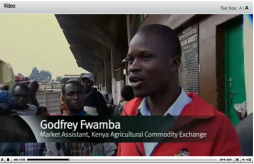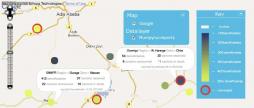Food Security
Posted by KatrinVerclas on Apr 22, 2009
Sensing is just one way in which mobiles are used in environmental protection. Another promising area is wildlife protection in sensitive areas where humans and animals collide, often to the detriment of protected animals. In the Laikipia District in Kenya, the University of Cambridge conducted a project using mobile phones to protect and manage Kenya's second largest elephant population, and the ecosystem they inhabit. The goal was to alleviate human-elephant conflict between local farmers and the protected elephants. The project used mobile phones for early warning of elephants approaching farmland by using 'push-to-talk' technologies, and GPS/GSM collars for the elephants, allowing wildlife personnel to intervene before elephant became a danger to farmers and vice versa.
Posted by KatrinVerclas on Apr 21, 2009
If 2009 is the year of the mobile phone for social impact, then Earth Day should mark a special occasion in this regard. More and more organizations and people are discovering how mobile phones can be used for social impact, including how to use mobile tech for environmental protection, sensing, and to leverage just-in-time information to make our movements and actions more environmentally friendly.
An emerging field of research, for example, uses mobiles for "urban sensing," allowing phones to collect scientific data in new and innovative ways. By affixing a sensory device to a mobile phone, mobile sensing provides the opportunity to track dynamic information about environmental impacts and develop maps and understand patterns of human movement, traffic, and air pollution.
A leader in this field is the University of California Los Angeles CENS Lab.
Posted by KatrinVerclas on Dec 21, 2008
Ethopia again this year has experienced crippling droughts. Faced with the possibility of famine, UNICEF Ethiopia launched a massive food distribution program to supply the high-protein food Plumpy'nut to under-nourished children using mobile phones for monitoring and delivering supplies its more than 1,8000 feeding centers in the country.
To coordinate the distribution and maintain appropriate stocks, field monitors reported on supplies and number of children fed through an SMS reporting system using a UNICEF-built mobile data collection and monitoring software, RapidSMS. We have previously reviewed RapidSMS here, comparing it with a less scaleable lower-end tool, Frontline SMS.
The emergency food supply chain before RapidSMS
Posted by cmasiello on Oct 29, 2008
Mobile phones bridge the rural digital divide, bring economic benefits, and act as agents of social mobilization through improved communication. But what are the real challenges of reaching rural areas, and what are some of today’s most beneficial applications that can help rural communities, specifically regarding agriculture development?
The Virtual Forum on "Mobile Telephony in Rural Areas" will examine the challenges that rural communities face in enhancing the benefits of mobile telephony, and look at some examples of interesting initiatives and good outcomes from around the globe.
Subject Matter experts include:




